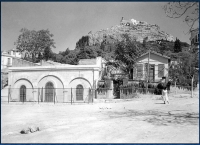| Recommended literature :
|
- E.D. Chiotis and G.P. Marinos(2012A): Geological aspects on the sustainability of ancient aqueducts of Athens (in: Bulletin of the geological society of Greece col 46 (2012) pag 25 - 36 in particular)
- E.D. Chiotis and L.E. Chioti (2012B): Water supply of Athens in the antiquity (in: A.N. Angelakis (2012): Evolution of water supply through the millennia), in particular pag 431 - 424)
- E.D. Chiotis (2018): The Hadrianic aqueduct of Athens and the underlying tradition of hydraulic engineering (in: G.A. Aristodemou (ed): Great waterworks in Greece (2018), pag 70 - 97)
- S. Leigh 1997: The ′reservoir′ of Hadrian in Athens (in: Journal of Roman Archaeology vol 10 (1997) pag 279 - 290)
- S. Leigh 1998: The aqueduct of Hadrian and the water supply of Roman Athens (PhD thesis)
|



